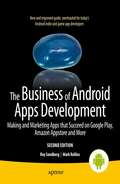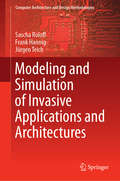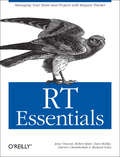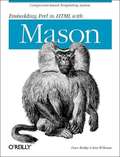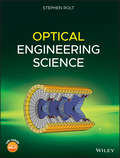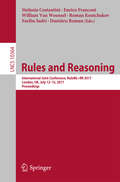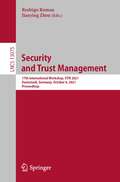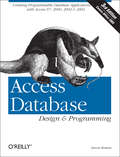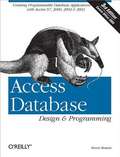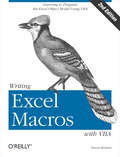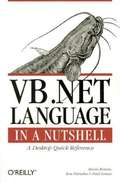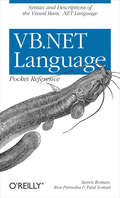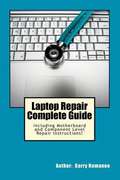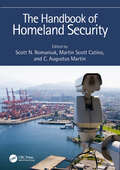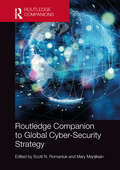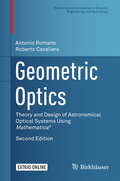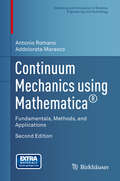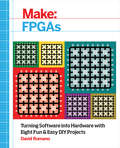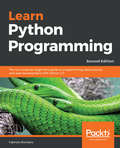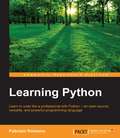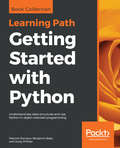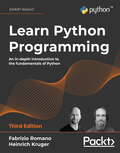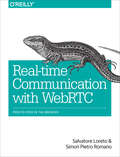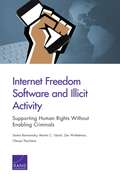- Table View
- List View
The Business of Android Apps Development: Making and Marketing Apps that Succeed on Google Play, Amazon Appstore and More
by Mark Rollins Roy SandbergThe growing but still evolving success of the Android platform has ushered in a second mobile technology "gold rush" for app developers. Google Play and Amazon Appstore for Android apps has become the second go-to apps eco for today's app developers. While not yet as large in terms of number of apps as iTunes, Google Play and Amazon Appstore have so many apps that it has become increasingly difficult for new apps to stand out in the crowd. Achieving consumer awareness and sales longevity for your Android app requires a lot of organization and some strategic planning. Written for today's Android apps developer or apps development shop, this new and improved book from Apress, The Business of Android Apps Development, Second Edition, tells you today's story on how to make money on Android apps. This book shows you how to take your app from idea to design to development to distribution and marketing your app on Google Play or Amazon Appstore. This book takes you step-by-step through cost-effective marketing, public relations and sales techniques that have proven successful for professional Android app creators and indie shops-perfect for independent developers on shoestring budgets. It even shows you how to get interest from venture capitalists and how they view a successful app vs. the majority of so-so to unsuccessful apps in Android. No prior business knowledge is required. This is the book you wish you had read before you launched your first app!
Modeling and Simulation of Invasive Applications and Architectures (Computer Architecture and Design Methodologies)
by Sascha Roloff Frank Hannig Jürgen TeichThis book covers two main topics: First, novel fast and flexible simulation techniques for modern heterogeneous NoC-based multi-core architectures. These are implemented in the full-system simulator called InvadeSIM and designed to study the dynamic behavior of hundreds of parallel application programs running on such architectures while competing for resources. Second, a novel actor-oriented programming library called ActorX10, which allows to formally model parallel streaming applications by actor graphs and to analyze predictable execution behavior as part of so-called hybrid mapping approaches, which are used to guarantee real-time requirements of such applications at design time independent from dynamic workloads by a combination of static analysis and dynamic embedding.
RT Essentials: Managing Your Team and Projects with Request Tracker
by Dave Rolsky Darren Chamberlain Richard Foley Robert Spier Jesse VincentIn a typical organization, there's always plenty that to do such as: pay vendors, invoice customers, answer customer inquiries, and fix bugs in hardware or software. You need to know who wants what and keep track of what is left to do. This is where a ticketing system comes in. A ticketing system allows you to check the status of various tasks: when they were requested, who requested them and why, when they were completed, and more. RT is a high-level, open source ticketing system efficiently enabling a group of people to manage tasks, issues, and requests submitted by a community of users. RT Essentials, co-written by one of the RT's original core developers, Jesse Vincent, starts off with a quick background lesson about ticketing systems and then shows you how to install and configure RT. This comprehensive guide explains how to perform day-to-day tasks to turn your RT server into a highly useful tracking tool. One way it does this is by examining how a company could use RT to manage its internal processes. Advanced chapters focus on developing add-on tools and utilities using Perl and Mason. There's also chapter filled with suggested uses for RT inside your organization. No matter what kind of data your organization tracks--from sales inquiries to security incidents or anything in between--RT Essentials helps you use RT to provide order when you need it most.
Embedding Perl in HTML with Mason
by Dave Rolsky Ken WilliamsMason doesn't aim to be the one true Perl-based templating system for building web sites, but it's led many programmers to abandon their custom solutions when they've seen how much easier using Mason can be. It's a powerful, open source, Perl-based web site development and delivery engine, with features that make it an ideal backend for high load sites serving dynamic content. Mason uses a concept called components: a mix of HTML, Perl, and special Mason commands. These components can be entire web pages, or bits of HTML that can be embedded in top-level components. Shared and reusable, these components greatly simplify site maintenance: when you change a shared component, you instantly change all pages that refer to it. Although using Mason isn't difficult, creating a Mason-based site can be tricky. Embedding Perl in HTML with Mason , written by members of Mason's core development team, shows you how to take advantage of Mason's strengths while avoiding the obstacles that inexperienced users may encounter. Mason's unique features, when used properly, can streamline the design of a web site or application. This concise book covers these features from several angles, and includes a study of the authors' sample site where these features are used. Embedding Perl in HTML with Mason shows you how to create large, complex, dynamically driven web sites that look good and are a snap to maintain. You'll learn how to visualize multiple Mason-based solutions to any given problem and select among them. The book covers the latest line of Mason development 1.1x, which has many new features, including line number reporting based on source files, sub-requests, and easier use as a CGI. The only book to cover this important tool, Embedding Perl in HTML with Mason is essential reading for any Perl programmer who wants to simplify web site design. Learn how to use Mason, and you'll spend more time making things work, and less time reinventing the wheel.
Optical Engineering Science
by Stephen RoltA practical guide for engineers and students that covers a wide range of optical design and optical metrology topics Optical Engineering Science offers a comprehensive and authoritative review of the science of optical engineering. The book bridges the gap between the basic theoretical principles of classical optics and the practical application of optics in the commercial world. Written by a noted expert in the field, the book examines a range of practical topics that are related to optical design, optical metrology and manufacturing. The book fills a void in the literature by coving all three topics in a single volume. Optical engineering science is at the foundation of the design of commercial optical systems, such as mobile phone cameras and digital cameras as well as highly sophisticated instruments for commercial and research applications. It spans the design, manufacture and testing of space or aerospace instrumentation to the optical sensor technology for environmental monitoring. Optics engineering science has a wide variety of applications, both commercial and research. This important book: Offers a comprehensive review of the topic of optical engineering Covers topics such as optical fibers, waveguides, aspheric surfaces, Zernike polynomials, polarisation, birefringence and more Targets engineering professionals and students Filled with illustrative examples and mathematical equations Written for professional practitioners, optical engineers, optical designers, optical systems engineers and students, Optical Engineering Science offers an authoritative guide that covers the broad range of optical design and optical metrology topics and their applications.
Rules and Reasoning
by Dumitru Roman Fariba Sadri Roman Kontchakov William Van Woensel Enrico Franconi Stefania CostantiniThis book constitutes the proceedings of the International Joint Conference on Rules and Reasoning, RuleML+RR 2017, held in London, UK, during July 2017. This is the first conference of a new series, joining the efforts of two existing conference series, namely "RuleML" (International Web Rule Symposium) and "RR" (Web Reasoning and Rule Systems). The 16 regular papers presented together with 2 keynote abstracts were carefully reviewed and selected from 29 submissions. The RR conference series has been a forum for discussion and dissemination of new results on all topics concerning Web Reasoning and Rule Systems, with an emphasis on rule-based approaches and languages. The RuleML conference series has been devoted to disseminating research, applications, languages and standards for rule technologies, with attention to both theoretical and practical developments, to challenging new ideas and industrial applications. Both series of conferences aimed at building bridges between academia and industry in the field of rules and their applications. Therefore, RuleML+RR is expected to become a leading conference for all subjects concerning theoretical advances, novel technologies, and innovative applications about knowledge representation and reasoning with rules. This new joint conference provides a valuable forum for stimulating cooperation and cross-fertilization between the many different communities focused on the research, development and applications of rule-based systems. It provides the possibility to present and discuss applications of rules and reasoning in academia, industry, engineering, business, finance, healthcare and other application areas.
Security and Trust Management: 17th International Workshop, STM 2021, Darmstadt, Germany, October 8, 2021, Proceedings (Lecture Notes in Computer Science #13075)
by Rodrigo Roman Jianying ZhouThis book constitutes the proceedings of the 17th International Workshop on Security and Trust Management, STM 2021, co-located with the 26th European Symposium on Research in Computer Security, ESORICS 2021. The conference was planned to take place in Darmstadt, Germany. It was held online on October 8, 2021, due to the COVID-19 pandemic.The 10 papers presented in this volume were carefully reviewed and selected from 26 submissions. They were organized in topical sections on applied cryptography; privacy; formal methods for security and trust; and systems security.
Access Database Design & Programming: Creating Programmable Database Applications with Access 97, 2000, 2002 & 2003 (Nutshell Handbooks)
by Steven RomanAccess Database Design & Programming takes you behind the details of the Access interface, focusing on the general knowledge necessary for Access power users or developers to create effective database applications. When using software products with graphical interfaces, we frequently focus so much on the interface that we forget about the general concepts that allow us to understand and use the software effectively. In particular, this book focuses on three areas:Database design. The book provides an enjoyable, informative overview of database design that carefully shows you how to normalize tables to eliminate redundancy without losing data. Queries. The book examines multi-table queries (i.e.,various types of joins) and shows how to implement them indirectly by using the Access interface or directly by using Access SQL. Programming. The book examines the VBA integrated development environment (IDE). It then goes on to provide an excellent introduction to Data Access Objects (DAO), ActiveX Data Objects (ADO), and ADO Extensions for Data Definition and Security (ADOX). These sections serve as a handy introduction and primer for basic database operations,such as modifying a table under program control, dynamically adding and deleting a record, and repositioning a record pointer. The concluding chapter focuses on common programming problems, such as computing running sums and comparing two sets. Unlike other Access books that take the long, detailed approach to every topic of concern to Access programmers, Access Database Design &Programming instead focuses on the core concepts, enabling programmers to develop solid, effective database applications. This book also serves as a 'second course' in Access that provides a relatively experienced Access user who is new to programming with the frequently overlooked techniques necessary to develop successfully in the Microsoft Access environment. Anyone interested in learning Access in depth, rather than just scraping the surface, will enjoy and benefit immensely from reading this book.
Access Database Design & Programming, 3rd Edition
by Steven RomanAccess Database Design and Programming takes you behind the details of the Access interface, focusing on the general knowledge necessary for Access power users or developers to create effective database applications. When using software products with graphical interfaces, we frequently focus so much on the interface that we forget about the general concepts that allow us to understand and use the software effectively. In particular, this book focuses on three areas: Database design. The book provides an enjoyable, informative overview of database design that carefully shows you how to normalize tables to eliminate redundancy without losing data. Queries. The book examines multi-table queries (i.e.,various types of joins) and shows how to implement them indirectly by using the Access interface or directly by using Access SQL. Programming. The book examines the VBA integrated development environment (IDE). It then goes on to provide an excellent introduction to Data Access Objects (DAO), ActiveX Data Objects (ADO), and ADO Extensions for Data Definition and Security (ADOX). These sections serve as a handy introduction and primer for basic database operations, such as modifying a table under program control, dynamically adding and deleting a record, and repositioning a record pointer. The concluding chapter focuses on common programming problems, such as computing running sums and comparing two sets. Unlike other Access books that take the long, detailed approach to every topic of concern to Access programmers, Access Database Design and Programming instead focuses on the core concepts, enabling programmers to develop solid, effective database applications. This book also serves as a 'second course' in Access that provides a relatively experienced Access user who is new to programming with the frequently overlooked techniques necessary to develop successfully in the Microsoft Access environment. Anyone interested in learning Access in depth, rather than just scraping the surface, will enjoy and benefit immensely from reading this book.
Writing Excel Macros with VBA
by Steven RomanNewly updated for Excel 2002, Writing Excel Macros with VBA, 2nd Edition provides Excel power-users, as well as programmers who are unfamiliar with the Excel object model, with a solid introduction to writing Visual Basic for Applications (VBA) macros and programs for Excel. In particular, the book focuses on:The Visual Basic Editor and the Excel VBA programming environment. Excel features a complete, state-of-the-art integrated development environment for writing, running, testing, and debugging VBA macros. The VBA programming language, the same programming language used by the other applications in Microsoft Office XP and 2000, as well as by the retail editions of Visual Basic 6.0. The Excel object model, including new objects and new members of existing objects in Excel 2002. Excel exposes nearly all of its functionality through its object model, which is the means by which Excel can be controlled programmatically using VBA. While the Excel object model, with 192 objects, is the second largest among the Office applications, you need to be familiar with only a handful of objects to write effective macros. Writing Excel Macros focuses on these essential objects, but includes a discussion of many more objects as well. Writing Excel Macros with VBA, 2nd Edition is written in a terse, no-nonsense manner that is characteristic of Steven Roman's straightforward, practical approach. Instead of a slow-paced tutorial with a lot of handholding, Roman offers the essential information about Excel VBA that you must master to write macros effectively. This tutorial is reinforced by interesting and useful examples that solve common problems you're sure to have encountered. Writing Excel Macros with VBA, 2nd Edition is the book you need to delve into the basics of Excel VBA programming, enabling you to increase your power and productivity.
Writing Excel Macros with VBA, 2nd Edition
by Steven RomanNewly updated for Excel 2002, Writing Excel Macros with VBA, 2nd Edition provides Excel power-users, as well as programmers who are unfamiliar with the Excel object model, with a solid introduction to writing Visual Basic for Applications (VBA) macros and programs for Excel. In particular, the book focuses on: * The Visual Basic Editor and the Excel VBA programming environment. Excel features a complete, state-of-the-art integrated development environment for writing, running, testing, and debugging VBA macros. The VBA programming language, the same programming language used by the other applications in Microsoft Office XP and 2000, as well as by the retail editions of Visual Basic 6.0. The Excel object model, including new objects and new members of existing objects in Excel 2002. Excel exposes nearly all of its functionality through its object model, which is the means by which Excel can be controlled programmatically using VBA. While the Excel object model, with 192 objects, is the second largest among the Office applications, you need to be familiar with only a handful of objects to write effective macros. Writing Excel Macros focuses on these essential objects, but includes a discussion of many more objects as well. Writing Excel Macros with VBA, 2nd Edition is written in a terse, no-nonsense manner that is characteristic of Steven Roman's straightforward, practical approach. Instead of a slow-paced tutorial with a lot of handholding, Roman offers the essential information about Excel VBA that you must master to write macros effectively. This tutorial is reinforced by interesting and useful examples that solve common problems you're sure to have encountered. Writing Excel Macros with VBA, 2nd Edition is the book you need to delve into the basics of Excel VBA programming, enabling you to increase your power and productivity.
VB .NET Language in a Nutshell
by Steven Roman Ron Petrusha Paul LomaxThe extensive changes to Visual Basic and the newness of the .NET platform call for a VB .NET reference guide oriented toward professional developers--those deeply experienced in Visual Basic and those adding VB .NET to their list of mastered languages. VB .NET Language in a Nutshell answers the call. As a reference book, it doesn't waste space on simple concepts, but documents, using practical examples, how language elements work, alternative approaches, optimal usage, and potential pitfalls. As a quick introduction, the first section of VB .NET Language in a Nutshell leads you through the important areas of programming VB .NET, including: Variables and Data Types Introduction to Object Oriented Programming The .NET Framework: General Concepts The .NET Framework Class Library Delegates and Events Error Handling What's New and Different in VB .NET Language Elements by category Operators Constants and Enumerations The VB .NET Command Line Compiler VB 6 Language Elements Not Supported by VB .NET The meat of the book is the alphabetical reference to the functions, statements, directives, objects, and object members that make up the VB .NET language. As an experienced developer, you can quickly get the whole story on a language element that interests you or seems to be behaving unexpectedly in your code. To ease your transition to .NET, there's a "VB .NET/VB 6 Differences" section for each language element. A hefty appendix section includes: No matter how much experience you have programming with VB, this is the kind of book you'll want to have close by, both as your standard reference guide and as a tool for troubleshooting and identifying programming problems.
VB.NET Language Pocket Reference
by Steven Roman Ron Petrusha Paul LomaxVisual Basic .NET is a radically new version of Microsoft Visual Basic, the world's most widely used rapid application development (RAD) package. Whether you are just beginning application development with Visual Basic .NET or are already deep in code, you will appreciate just how easy and valuable the VB.NET Language Pocket Reference is. VB.NET Language Pocket Reference contains a concise description of all language elements by category. These include language elements implemented by the Visual Basic compiler, as well as all procedures and functions implemented in the Microsoft.VisualBasic namespace. Use it anytime you want to look up those pesky details of Visual Basic syntax or usage. With concise detail and no fluff, you'll want to take this book everywhere.
Laptop Repair Complete Guide; Including Motherboard Component Level Repair!
by Garry RomaneoThis book will educate you on the Correct Process of Repairing The Entire Laptop, Including and concentrating more on Motherboard Repair Instruction, Screen Repairing, Component Level Diagnosing and Repairing. This is the 3rd Book Released By Author Garry Romaneo, The Worlds Leading Laptop Repair Technician, Author, and Consultant. The book will take you through the laptops disassembly process, Explaining in detail how to disassemble all laptops. You will then be taught all about Liquid Spills to Laptops. What to do, What not to do, How to Remove Liquid and How To Repair Any Damage from Liquid to parts or components. You will be shown all the various tools to be used in laptop repair both hand tools and electronic tools explained. This book will then explain the entire upper end repairing techniques. Replacing screens - how to- then it will show you in great detail how to disassembly the screen and repair or replace the LCD ccfl Bulb, the book will also discuss LED screens. You will be taught step by step how to solder a motherboard whether it is the components or the dc jack. The DC Jack Repair/Desoldering instructions are included. Most importantly, this book will teach you laptop motherboard repairing techniques. Learn to identify the parts and components on the motherboard, learn component replacement, motherboard testing techniques and more. This book also includes the authors Patented/Copyrighted and Trademarked Laptop Video Chip/GPU Motherboard Online Repair instruction. There is alot more included (Part Identification, Hard Drive Failure Issues etc. . . )so check it out now. Going Above And Beyond CompTia A+ Certification !!!
The Handbook of Homeland Security
by Scott N. Romaniuk Martin Scott Catino C. Augustus MartinThe Handbooks of Homeland Security Handbook is a convenient, one-stop reference and guide to the latest regulations and developments in all things relevant to the homeland security and defense domain. The book is divided into five parts and addresses such critical areas of as countering terrorism, critical infrastructure protection, information and cybersecurity, military and private sector support for Homeland Security, risk assessment, and preparedness for all-hazards and evolving threats. In total, more than 100 chapters outline the latest developments in homeland security policies, directives, and mandates as well as emergent threats and topical considerations for the Department of Homeland Security (DHS) and its stake-holders. The diverse array of chapter topics covered—contributed to by dozens of top experts in the field—provides a useful and important resource for any student, professional, researcher, policy-maker, or library in understanding the domestic initiatives of public-sector Homeland Security entities and their responsibilities in the current global environment.
Routledge Companion to Global Cyber-Security Strategy
by Scott N. Romaniuk Mary ManjikianThis companion provides the most comprehensive and up-to-date comparative overview of the cyber-security strategies and doctrines of the major states and actors in Europe, North America, South America, Africa, and Asia. The volume offers an introduction to each nation’s cyber-security strategy and policy, along with a list of resources in English that may be consulted for those wishing to go into greater depth. Each chapter is written by a leading academic or policy specialist, and contains the following sections: overview of national cyber-security strategy; concepts and definitions; exploration of cyber-security issues as they relate to international law and governance; critical examinations of cyber partners at home and abroad; legislative developments and processes; dimensions of cybercrime and cyberterrorism; implications of cyber-security policies and strategies. This book will be of much interest to students and practitioners in the fields of cyber-security, national security, strategic studies, foreign policy, and international relations.
Geometric Optics
by Antonio Romano Roberto CavaliereThis book--unique in the literature--provides readers with the mathematical background needed to design many of the optical combinations that are used in astronomical telescopes and cameras. The results presented in the work were obtained by using a different approach to third-order aberration theory as well as the extensive use of the software package Mathematica®. Replete with workout examples and exercises, Geometric Optics is an excellent reference for advanced graduate students, researchers, and practitioners in applied mathematics, engineering, astronomy, and astronomical optics. The work may be used as a supplementary textbook for graduate-level courses in astronomical optics, optical design, optical engineering, programming with Mathematica, or geometric optics.
Continuum Mechanics using Mathematica®: Fundamentals, Methods, and Applications (Modeling and Simulation in Science, Engineering and Technology)
by Antonio Romano Addolorata MarascoThis textbook's methodological approach familiarizes readers with the mathematical tools required to correctly define and solve problems in continuum mechanics. Covering essential principles and fundamental applications, this second edition of Continuum Mechanics using Mathematica® provides a solid basis for a deeper study of more challenging and specialized problems related to nonlinear elasticity, polar continua, mixtures, piezoelectricity, ferroelectricity, magneto-fluid mechanics and state changes (see A. Romano, A. Marasco, Continuum Mechanics: Advanced Topics and Research Trends, Springer (Birkhäuser), 2010, ISBN 978-0-8176-4869-5). Key topics and features: * Concise presentation strikes a balance between fundamentals and applications * Requisite mathematical background carefully collected in two introductory chapters and one appendix * Recent developments highlighted through coverage of more significant applications to areas such as wave propagation, fluid mechanics, porous media, linear elasticity. This second edition expands the key topics and features to include: * Two new applications of fluid dynamics: meteorology and navigation * New exercises at the end of the existing chapters * The packages are rewritten for Mathematica 9 Continuum Mechanics using Mathematica®: Fundamentals, Applications and Scientific Computing is aimed at advanced undergraduates, graduate students and researchers in applied mathematics, mathematical physics and engineering. It may serve as a course textbook or self-study reference for anyone seeking a solid foundation in continuum mechanics.
Make: FPGAs
by David RomanoWhat if you could use software to design hardware? Not just any hardware--imagine specifying the behavior of a complex parallel computer, sending it to a chip, and having it run on that chip--all without any manufacturing? With Field-Programmable Gate Arrays (FPGAs), you can design such a machine with your mouse and keyboard. When you deploy it to the FPGA, it immediately takes on the behavior that you defined. Want to create something that behaves like a display driver integrated circuit? How about a CPU with an instruction set you dreamed up? Or your very own Bitcoin miner You can do all this with FPGAs. Because you're not writing programs--rather, you're designing a chip whose sole purpose is to do what you tell it--it's faster than anything you can do in code. With Make: FPGAs, you'll learn how to break down problems into something that can be solved on an FPGA, design the logic that will run on your FPGA, and hook up electronic components to create finished projects.
Learn Python Programming: A beginner's guide to learning the fundamentals of Python language to write efficient, high-quality code, 2nd Edition
by Fabrizio RomanoBuild a solid foundation in coding by utilizing the language and its core characteristicsKey FeaturesLeverage the features of Python programming through easy-to-follow examplesDevelop a strong set of programming skills that can be applied on all platformsCreate GUIs and data science-based applicationsBook DescriptionLearn Python Programming creates a foundation for those who are interested in developing their skills in Python programming. The book starts with the fundamentals of programming with Python and ends by exploring different topics such as GUIs and real-world apps.You will begin by exploring the foundations of and fundamental topics on Python and learn to manipulate them. Then, you'll explore different programming paradigms that will allow you to find the best approach to a situation, and you’ll also understand how to carry out performance optimization as well as effective debugging.As you make your way through the chapters, you'll control the flow of a program, and persist and utilize an interchange format to exchange data. You'll also walk through cryptographic services in Python and understand secure tokens. Throughout, the book covers various types of applications, and it concludes with building real-world applications based on all the concepts that you learned.By the end of the book, you'll have a proper understanding of the Python language and a solid grasp on how to work with data. You'll know how to quickly build a website and harness the power of Python's renowned data science libraries.What you will learnGet Python up and running on Windows, Mac, and LinuxGrasp fundamental concepts of coding using data structures and control flowWrite elegant, reusable, and efficient code in any situationUnderstand when to use the functional or object-oriented programming (OOP) approachWalk through the basics of security and concurrent/asynchronous programmingCreate bulletproof, reliable software by writing testsExplore examples of GUIs, scripting, and data scienceWho this book is forLearn Python Programming is for individuals with relatively little experience in coding or Python. It's also ideal for aspiring programmers who need to write scripts or programs to accomplish tasks. The book takes you all the way to creating a full-fledged application.
Learning Python
by Fabrizio RomanoLearn to code like a professional with Python - an open source, versatile and powerful programming language About This Book * Learn the fundamentals of programming with Python - one of the best languages ever created * Develop a strong set of programming skills that you will be able to express in any situation, on every platform, thanks to Python's portability * Create outstanding applications of all kind, from websites to scripting, and from GUIs to data science Who This Book Is For Python is the most popular introductory teaching language in U.S. top computer science universities, so if you are new to software development, or maybe you have little experience, and would like to start off on the right foot, then this language and this book are what you need. Its amazing design and portability will help you become productive regardless of the environment you choose to work with. What You Will Learn * Get Python up and running on Windows, Mac, and Linux in no time * Grasp the fundamental concepts of coding, along with the basics of data structures and control flow. * Write elegant, reusable, and efficient code in any situation * Understand when to use the functional or the object oriented programming approach * Create bulletproof, reliable software by writing tests to support your code * Explore examples of GUIs, scripting, data science and web applications * Learn to be independent, capable of fetching any resource you need, as well as dig deeper In Detail Learning Python has a dynamic and varied nature. It reads easily and lays a good foundation for those who are interested in digging deeper. It has a practical and example-oriented approach through which both the introductory and the advanced topics are explained. Starting with the fundamentals of programming and Python, it ends by exploring very different topics, like GUIs, web apps and data science. The book takes you all the way to creating a fully fledged application. The book begins by exploring the essentials of programming, data structures and teaches you how to manipulate them. It then moves on to controlling the flow of a program and writing reusable and error proof code. You will then explore different programming paradigms that will allow you to find the best approach to any situation, and also learn how to perform performance optimization as well as effective debugging. Throughout, the book steers you through the various types of applications, and it concludes with a complete mini website built upon all the concepts that you learned. Style and approach This book is an easy-to-follow guide that will take you from a novice to the proficient level at a comfortable pace, using a lot of simple but effective examples. Each topic is explained thoroughly, and pointers are left for the more inquisitive readers to dig deeper and expand their knowledge.
Getting Started with Python: Understand key data structures and use Python in object-oriented programming
by Fabrizio Romano Benjamin Baka Dusty PhillipsHarness the power of Python objects and data structures to implement algorithms for analyzing your data and efficiently extracting informationKey FeaturesTurn your designs into working software by learning the Python syntaxWrite robust code with a solid understanding of Python data structuresUnderstand when to use the functional or the OOP approachBook DescriptionThis Learning Path helps you get comfortable with the world of Python. It starts with a thorough and practical introduction to Python. You’ll quickly start writing programs, building websites, and working with data by harnessing Python's renowned data science libraries. With the power of linked lists, binary searches, and sorting algorithms, you'll easily create complex data structures, such as graphs, stacks, and queues. After understanding cooperative inheritance, you'll expertly raise, handle, and manipulate exceptions. You will effortlessly integrate the object-oriented and not-so-object-oriented aspects of Python, and create maintainable applications using higher level design patterns. Once you’ve covered core topics, you’ll understand the joy of unit testing and just how easy it is to create unit tests.By the end of this Learning Path, you will have built components that are easy to understand, debug, and can be used across different applications.This Learning Path includes content from the following Packt products:Learn Python Programming - Second Edition by Fabrizio RomanoPython Data Structures and Algorithms by Benjamin BakaPython 3 Object-Oriented Programming by Dusty PhillipsWhat you will learnUse data structures and control flow to write codeUse functions to bundle together a sequence of instructionsImplement objects in Python by creating classes and defining methodsDesign public interfaces using abstraction, encapsulation and information hidingRaise, define, and manipulate exceptions using special error objectsCreate bulletproof and reliable software by writing unit testsLearn the common programming patterns and algorithms used in PythonWho this book is forIf you are relatively new to coding and want to write scripts or programs to accomplish tasks using Python, or if you are an object-oriented programmer for other languages and seeking a leg up in the world of Python, then this Learning Path is for you. Though not essential, it will help you to have basic knowledge of programming and OOP.
Learn Python Programming: An in-depth introduction to the fundamentals of Python, 3rd Edition
by Fabrizio Romano Heinrich KrugerGet up and running with Python through concise tutorials and practical projects in this fully updated editionKey FeaturesDiscover how to think like a Python programmerExtensively revised with richer examples, Python 3.9 syntax, and new chapters on APIs and packaging and distributing Python codeLearn the fundamentals of Python through real-world projects in API development, GUI programming, and data scienceBook DescriptionLearn Python Programming, Third Edition is both a theoretical and practical introduction to Python, an extremely flexible and powerful programming language that can be applied to many disciplines. This book will make learning Python easy and give you a thorough understanding of the language. You'll learn how to write programs, build modern APIs, and work with data by using renowned Python data science libraries.This revised edition covers the latest updates on API management, packaging applications, and testing. There is also broader coverage of context managers and an updated data science chapter.The book empowers you to take ownership of writing your software and become independent in fetching the resources you need. You will have a clear idea of where to go and how to build on what you have learned from the book. Through examples, the book explores a wide range of applications and concludes by building real-world Python projects based on the concepts you have learned.What you will learnGet Python up and running on Windows, Mac, and LinuxWrite elegant, reusable, and efficient code in any situationAvoid common pitfalls like duplication, complicated design, and over-engineeringUnderstand when to use the functional or object-oriented approach to programmingBuild a simple API with FastAPI and program GUI applications with TkinterGet an initial overview of more complex topics such as data persistence and cryptographyFetch, clean, and manipulate data, making efficient use of Python's built-in data structuresWho this book is forThis book is for anyone who has some programming experience, but not necessarily with Python. Some knowledge of basic programming concepts will come in handy, although it is not a requirement.
Real-Time Communication with WebRTC
by Simon Pietro Romano Salvatore LoretoDeliver rich audio and video real-time communication and peer-to-peer data exchange right in the browser, without the need for proprietary plug-ins. This concise hands-on guide shows you how to use the emerging Web Real-Time Communication (WebRTC) technology to build a browser-to-browser application, piece by piece.The authors' learn-by-example approach is perfect for web programmers looking to understand real-time communication, and telecommunications architects unfamiliar with HTML5 and JavaScript-based client-server web programming. You'll use a ten-step recipe to create a complete WebRTC system, with exercises that you can apply to your own projects.Tour the WebRTC development cycle and trapezoid architectural modelUnderstand how and why VoIP is shifting from standalone functionality to a browser componentUse mechanisms that let client-side web apps interact with browsers through the WebRTC APITransfer streaming data between browser peers with the RTCPeerConnection APICreate a signaling channel between peers for setting up a WebRTC sessionPut everything together to create a basic WebRTC system from scratchLearn about conferencing, authorization, and other advanced WebRTC features
Internet Freedom Software and Illicit Activity: Supporting Human Rights Without Enabling Criminals
by Sasha Romanosky Martin C. Libicki Zev Winkelman Olesya TkachevaThis report examines the portfolio of tools funded by the State Department s Bureau of Democracy, Human Rights, and Labor that help support Internet freedom and assesses the impact of these tools in promoting U. S. interests (such as freedom of expression, freedom of the press, and the free flow of information) without enabling criminal activity. "
